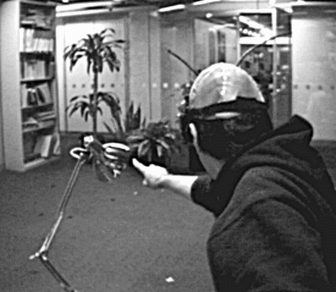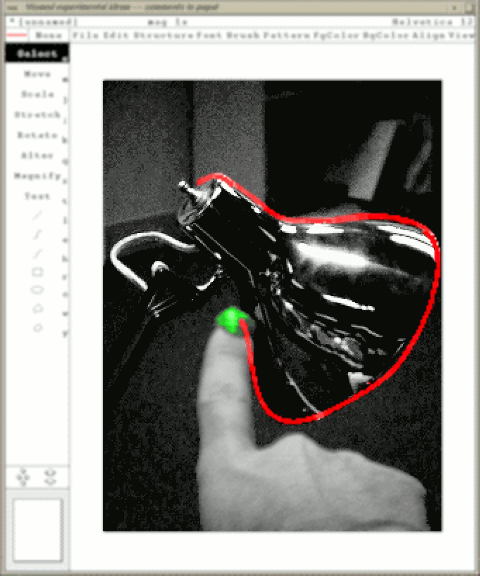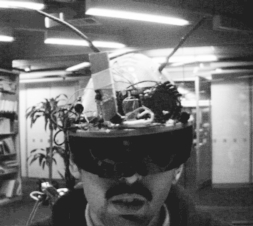Synthetic Synesthesia of the Sixth Sense™
6ense™ (SixthSense™)
SixthSense (abbr. "6ense", as in SIXense) describes a variety of wearable
technologies (neckworn, headwork, wristworn, etc.), including
a device that comprises
a neckworn pendant containing both a camera and a data projector capable of
projecting onto 3D subject matter such as the wearer's own hands or other 3D
objects in front of the wearer.
The projector + camera combination
augments the physical world with computer-generated/mediated
content and allows the wearer to interact using a Natural User Interface
(e.g. hand gestures or real physical objects) to interact with
that content.
It was invented by Steve Mann, and, later, further refined (and popularized)
by Pranav Mistry, both Mann and Mistry being PhD students in the MIT Media Lab.

Steve Mann using Sixth Sense in his everyday life in 1998. The hand gesture
is recognized
(in some applications by the wearable computer, and in some
applications by another person being collaborated with)
without the use of any colored tape or markings, which
were required (for computer recognition)
on Mann's earlier (IEEE Computer, Vol. 30, No. 2, February, 1997) apparatus,
as well as on Mistry et al.'s 2009 apparatus.
Earlier version of 6ense was headworn, and included gesture-sensing:



Neckworn 6ense:
In the 1990s Mann developed a wearable computer system with a webcam and
projector having infinite depth-of-focus so that it could project onto the
wearer's hands (and gestures) or arbitrary 3D objects and surfaces in
front of the wearer.
History
SixthSense originated as a variety of wearable technologies including
headworn, neckworn, wristworn, etc., including the
neckworn projector+camera system developed by Media Lab student Steve Mann[1].
Mann originally referred to these wearable technologies
as "Synthetic Synesthesia of the Sixth Sense"[3][4]. In the 1990s and
early 2000s, Mann used this project as a teaching example, and taught
several hundred students how to build the neckworn SixthSense system,
as part of the undergraduate teaching curriculum at University of Toronto[5].
In the 1990s the early aremac did vector graphics rather than raster
graphics[2], but a raster graphics version based on a miniature wearable
micromirror projector was developed in 2001, which could project onto the
wearer's hands, other objects, or the floor or ground in front of the
wearer, so that it could work with hand gestures or foot gestures[3].
Applications
One application of SixthSense was Computer Supported Collaborative Living,
e.g. telepresence, and remote interaction with others.
One example of this was Telepointer in which a Natural User Interface was
developed using a second projector and camera.
Other applications included interaction with a wearable computer
(in the absence of one or more remote parties).
SixthSense implemented various applications
such as computing the size of objects, or query on objects, done using a
reach and grab or ``hug'' gesture.
For example, reaching with open arms towards a tree provides a lookup of the
tree and attempts to recognize the bark on the tree, or attempts to use
a BARKode identifier on the tree.
A paper viewing
application lets the user navigate a sheet of paper,
displayed using paper-bending gestures.
A
drawing application lets the user draw on any surface by tracking the
fingertip movements of the user's index finger.
(This work was published by Mann in IEEE Computer, 1997, but then required
colored tape on Mann's index finger).
By 1998 SixthSense also recognized non-taped finger gestures.
A zooming gesture works by boxing a scene with
two cropping ``L'' shapes and pulling the hands apart or moving them
closer together.
A xylophone gesture allows the wearer to use any surface as a musical instrument
by implementing an idioscopic Natural User Interface.
The wearer can interact with any
floor, wall, board, or other surace, and
and ``flashback'' photos (s)he has captured.
SixthSense also lets the wearer draw in the air, as if making a
long-exposure photograph, moving a finger (or light source or other
object).
SixthSense augmediates real-world objects or body parts with the aremac by
projecting indicia (text, graphics, symbols, etc.) onto the objects or the
wearer's own hands, for example.
SixthSense can recognize pages of a book
and play back live video instructions or details or examples
as if they were affixed to the paper as a foldable display.
References
- "Telepointer: Hands-Free Completely Self Contained Wearable Visual Augmented Reality without Headwear and without any Infrastructural Reliance", IEEE International Symposium on Wearable Computing (ISWC00), pp. 177, 2000, Los Alamitos, CA, USA
- Intelligent Image Processing, John Wiley and Sons, 2001
- "Cyborg: Digital Destiny and Human Possibility in the Age of the Wearable Computer", Steve Mann with Hal Niedzviecki, ISBN: 0385658257 (Hardcover), Random House Inc, 304 pages, 2001.
- The Body Electric: An Anatomy of the New Bionic Senses [Hardcover], by James Geary, 2002, 214 pages
- CBC TV, interview, 2001
- [...]
See also:




![]()
